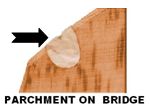Strings sit in their own individual, carved out notch, one for each string.

This notch is called the – String Groove.
As you learned earlier, the maple wood used for bridges is strong. That is one reason that maple is used. Because of its fine grain, maple allows rapid transmission of sound. These qualities make it the perfect wood for its purpose.
Some string-instrument bridges use an ebony insert. Ebony is among the hardest of woods, and it serves to reduce string groove wear caused by the highest tension strings. Ebony has a tighter grain than even maple. Using an ebony insert is one solution for aiding in counteracting the effects of friction on the string groove.

It is important for the string to sit in the string groove, without being pinched. Groove channels often are very effectively lubricated with pencil graphite.
Another solution used by luthiers to combat friction, is to glue parchment or material used on drum heads over the string groove.

Bridges are curved in order to match the shape of the instrument and more effectively support the strings.





